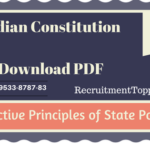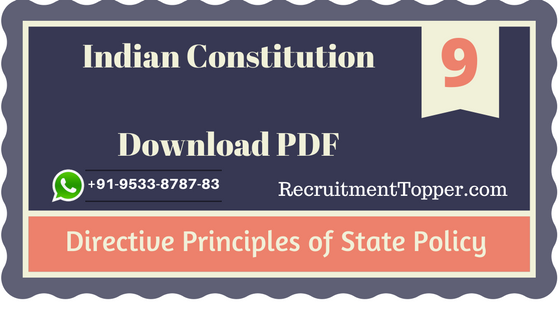Indian Constitution | Directive Principles of State Policy Download PDF
PART IV of the Constitution [Arts. 36-51] contains the Directive Principles of State Policy.
Classification of the Directives
Principles may be the Directives. classified under several groups:
(i) Certain ideals, particularly economic, which, according to the framers of the Constitution, the State1 should strive for.
(ii) Certain directions to the Legislature and the Executive intended to show in what manner the State should exercise their legislative and executive powers.
(iii) Certain rights of the citizens which shall not be enforceable by the Courts like the ‘Fundamental Rights’, but which the State1 shall nevertheless aim at securing, by regulation of its legislative and administrative policy.
Scope of the Directives
It shall be the duty of the State to follow these principles both in the , matter of administration as well as in the making of laws. They embody the object of the State under the republican Constitution, namely, that it is to be a ‘Welfare State’ and not a mere ‘Police State’. Most of these Directives, it will be seen, aim at the establishihent of the economic and social democracy which is pledged for in the Preamble.
Nature of Economic Democracy envisaged
According to Sir Ivor Jennings, the philosophy underlying most of these provisions is “Fabian Socialism without the socialism, for, only the nationalisation of the means of ‘production, Nature of the distribution and exchange’ is missing”. This much is clear however, that our Constitution (as framed in 1949) did not adhere to any particular ‘ism’ but sought to effect a compromise between Individualism and Socialism by eliminating the vices of unbridled private enterprise and interest by social control and welfare measures as far as possible.
Socalistic pattern of society
This is why a ‘‘Socialistic pattern of society’, not ‘‘socialism’, was declared to be the objective of our Planning by Pandit Nehru:
“Socialism to some people means two things: Distribution which means cutting off the pockets of the people who have too much money and nationalisation. Both these are desirable objectives, but neither is by itself Socialism.
Any attempt to distribute by affecting the productive machinery is utterly wrong; to do so would be to weaken ourselves. The basis of Socialism is greater wealth; there cannot be any Socialism of poverty. Therefore, the process of equalisation has to be phased.
Secondly, there is the question of nationalisation. I think it is dangerous merely to nationalise something without being prepared to work it properly. To nationalise we have to select things. My idea of Socialism is that every individual in the State should have equal opportunity for progress. ”
Trends towards collectivism
It must be mentioned, in this context, that the governmental policy, at the Union level, had demonstrated a greater bias towards collectivism during the regime of his daughter, Mrs. Indira Gandhi, and quite a number of industries, trades and other means of production were nationalised during the three decades since independence, either directly or through the agency of State-owned or State-controlled corporations, e.g., banking, insurance, aviation, coal mines.
The 42nd Amendment
It should, however, be mentioned that though the objective of the State has been described to be ‘socialist’, by the amendment of the Preamble by the 42nd Amendment Act, Mrs. Gandhi had said that this socialism did not indicate collectivism, but the offering of equal opportunities to all through socio-economic reform.By the same Amendment, certain other changes have been introduced in Part IV, adding new Directives, to accentuate the socialistic bias of the Constitution:
(i) Art. 39A has been inserted to enjoin the State to provide free legal aid to the poor and to take other suitable steps to ensure equal justice to all, which is offered by the Preamble.6
(ii) Art. 43A has been inserted in order to direct the State to ensure the participation of workers in the management of industry and other undertakings (this is what is known as ‘profit-sharing’). This is a positive step in advancement of socialism in the sense of economic justice.’
The 44th Amendment
This innocently-looking amendment is to be read along with elimination of the Fundamental Right to Property. They have paved the way for confiscatory taxation and for equalising salaries and wages for different vocations and different categories of work, which would usher in a socialistic society, even without resorting to nationalisation of the means of production.
Art. 38 enjoins the State to strive to promote the welfare of the people by securing and protecting, as effectively as it may, the social order in which justice—social, economic and political—shall, inform all the institutions of national life striving to minimising inequalities in income and endevour to eliminate inequalities in status, facilities, opportunities among individuals and groups of people residing in different areas or engaged in different avocations.
The 86th Amendment
The Constitution (Eighty-sixth Amendment) Act, 2002 substituted Art. 45 making provision for early childhood care and education to children below the age of six years in men ‘ place of provision for free and compulsory education until they completed the age of fourteen years.
The 97th Amendment
The Constitution (Ninety-seventh) Amendment Act, 2011 has inserted Art. 43B in Part IV of the Constitution to promote The 97th Amend- voluntary formation of co-operative societies. Article ment’ 43B provides that—
“The State shall endeavour to promote voluntary formation, autono¬mous functioning, democratic control and professional management of cooperative societies.”
The Directives, however, differ from the Fundamental Rights contained in Part IQ of the Constitution or the ordinary laws of the land, in the following respects: .
Directives compared with Fundamental Rights
(i) While the Fundamental Rights constitute limi-tations upon State action, the Directive Principles are in the nature of instruments of instruction to the Government of the day to do certain things and to achieve certain ends by their actions.
(ii) The Directives, however, require to be implemented by legislation, and so long as there is no law carrying out the policy laid down in a Directive, neither the State nor an individual can violate any existing law or legal right under colour of following a Directive.
Non-justiciability
(iii) The Directives are not enforceable in the Non-justiciability. Courts and do not create any justiciable rights in favour of the individuals.
From the standpoint of the individual, the difference between the Fundamental Rights and the Directives is that between justiciable and non- justiciable rights—a classification which has been adopted by the framers of our Constitution from the Constitution of Eire. Thus, though the Directive under Art. 43 enjoins the State to secure a living wage to all workers, no worker can secure a living wage by means of an action in a Court, so long as it is not implemented by appropriate legislation. In other words, the Courts are not competent to compel the Government to carry out any Directive, e.g., to provide for free compulsory education within the time limited by Art. 45or to undertake legislation to implement any of the Directive Principles.
Conflict between Fundamental Rights and Directive Principles
(iv) It may be observed that the declarations made in Part IV of the Constitution under the head ‘Directive Principles of Fundamental State Policy’ are in many cases of a wider import than Rights and declarations made in Part III as ‘Fundamental e Principles. Rights’. Hence, the question of priority in case of conflict between the two classes of provisions may easily arise. But while the Fundamental Rights are enforceable by the Courts [Arts. 32, 226(1) and the Courts are bound to declare as void any law that is inconsistent with any of the ‘Fundamental Rights’, the Directives are not so enforceable by the Courts [Art. 37], and the Courts cannot declare as void any law which is otherwise valid, on the ground that it contravenes any of the ‘Directives’. Hence, in case of any conflict between Parts IH and Iv of the Constitution, the former should prevail in the Courts.
The foregoing general proposition, laid down by the Supreme Court in 1951,9 must now, however, be read subject to a major exception. Article 31C, introduced in 1971 and expanded by the Constitution (42nd Amendment) Act, says that though the Directives themselves are not directly enforceable in the Courts, if any law is made to implement any of the Directives contained in Part IV of the Constitution, it would be totally immune from unconstitutionality on the ground of contravention of the fundamental rights conferred by Arts. 14 and 19.
This attempt to confer a primacy upon the Directives as against the Fun-damental Rights has, however, been foiled by the majority of the Supreme Court in the Minerva Mills case in two respects:
(a) It has struck down the widening of Art. 31C to include any or all of the Directives in Part IV, on the ground that such total exclusion of judicial review would offend the ‘basic structure’ of the Constitution. In the result, Art. 31C is restored to its pre-1976 position, so that a law would be protected by Art. 31C only if it has been made to implement the directive in Art. 39(b)-(c) and not any of the other Directives included in Part IV.
(b) It has been also held that there is a fine balance in the original Constitution as between the Directives and the Fundamental Rights, which should be adhered to by the Courts, by a harmonious reading of the two categories of provisions, instead of giving any general preference to the Directive Principles.
It is also to be noted that outside these two10 fundamental rights [in Arts. 14 and 19], the general proposition laid down in 19519 shall subsist. Thus, by way of implementing the Directive in Art. 45,—to provide free and compulsory education to children,8A—the State cannot override the fundamental rignt, under Art. 30(1), of minority communities to establish educa¬tional institutions of their own choice. The Supreme Court observed that:
The directive Drincmles of State oolicv have to conform to and run as subsidiary to the Chanter on Fundamental Rights”. Nevertheless, in determining the scone and ambit of the fundamental rights relied on bv or on behalf of anv nerson or bodv the court mav not entirely ignore these directive nrincinles of State oolicv laid down in Part IV of the Constitution but should adoot the orinciole of harmonious construction and should attempt to give effect to both as much as possible.
It has been held that the fundamental rights and the directive principles are the two wheels of the chariot as an aid to make social and economic democracy a truism.
Role of Judiciary in Harmonising
It is significant to note that among several Articles enshrined under Part IV of the Indian Constitution, Article 45 had been given much importance, as education is the basic necessity of the democracy and if the people are denied their right to education, then democracy will be paralyzed; and it was, therefore, emphasized that the objectives enshrined under Article 45 in Chapter IV of the Constitution should be achieved within ten years of the adoption of the Constitution. By establishing the obligations of the State, the Founding Fathers made it the responsibility of future governments to formulate a programme in order to achieve the given goals, but the unresponsive and sluggish attitude of the government to achieve the objectives enshrined under Article 45, belied the hopes and aspirations of the people. However, the Tudiciary showed keen interest in providing free and compulsory education to all the children below the age of fourteen years. In the case of Mohini Jain . State of Karnataka and others, (1992) SCC 666, the Hon’ble Supreme court held that right to education is a fundamental right enshrined under Article 21 of the Constitution. The right to education springs from right to life. The right to life under Article 21 and the dignity of the individual cannot fully be appreciated without the enjoyment of right to education. The Supreme Court observed: “Right to life” is the compendious expression for all those rights which the Courts must enforce because they are basic to the dignified enjoyment of life. It extends to the full range of conduct which the individual is free to pursue. The right to education flows directly from right to life. The right to life under Article 21 and the dignity of an individual cannot be assured unless it is accompanied bv the right to education. The State Government is under an obligation to make endeavour to provide educational facilities at all levels to its citizens. In the case of Unni Krishnan J.P. and others v. State of Andhra Pradesh and others reported in (1993) 1 SCC 645, the Supreme Court while examining the decision of Mohini fain’s case, partly overruled the decision rendered in Mohini Jain’s case and held that, the right to education is implicit in the right to life and personal liberty guaranteed by Article 21 and must be interpreted in the light of the Directive Principles of State Policy contained in Articles 41, 45 and 46, however, limited the State obligation to provide educational facilities as follows: (i) Every Citizen of this Country has a right to free education until he completes the age of fourteen years; (ii) Bevond that stage, his right to education is subject to the limits of the economic capacity of the state. Again in Bandhua Mukti Morcha v. Union of India and others, reported in (1997) 10 SCC 549, Tustice K. Ramaswamv and Tustice Saghir Ahmad while observing that illiteracy has many adverse effects in a democracy governed bv a rule of law, held that educated citizens could meaningfully exercise their political rights, discharge social responsibilities satisfactorily and develop spirit of tolerance and reform. Therefore, compulsory education is one of the essentials for the stability of democracy, social integration and to eliminate social evils. The supreme Court by righdy and harmoniously construing the provisions of Part III and IV of the Constitution has made Right to education a basic fundamental right.
Under the backdrop of the aforementioned declarations by the Supreme court of India, the Government of India by Constitutional (86th Amendment Act) Act, 2002 had added a new Article 21A, which provides that “the state shall provide free and compulsory education to all children of the age of 6 to 14 years in such manner as the State may, by law determine”. Further, they strengthened this Article 21A by adding a clause (k) to Article 51-A, which provides for those who are a parent or guardian to provide opportunities for education to his/her child or ward between the age of 6 and 14 years. On the basis of the Constitutional mandate provided under Articles 41, 45, 46, 21-A, 51-A(k) and various judgments of the Supreme Court of India, both the Government of India, as well as the supreme Court of India has taken several steps to eradicate illiteracy, improve the quality of education and simultaneously ensure that the dropouts are brought to nil. Some of these programmes are the National Technology Mission, District Primary Education Programme, and Nutrition Support for Primary Education, National Open School, Mid-Day Meal Scheme, Sarva Siksha Abhivan and other state specific initiatives. Besides this, several States have enacted legislations to provide free and compulsory primary education such as: The Right of Children to Free and Compulsory Education Act, 2009, The Kerala Education Act 1959, The Puniab Primary Education Act 1960, The Gujarat Compulsory Primary Education Act 1961, U.P. Basic Education Act 1972, Rajasthan Primary Education Act 1964, Tamil Nadu Right of Children to Free and Compulsory Education Rules, 2011, etc.
The integrative approach towards fundamental rights and directive principles or that the both should be interpreted and read together has now come to hold the field. It has now become a judicial strategy to read fundamental rights along with Directive principles with a view to define the scope and ambit of the former. Mostly directive principles have been used to broaden and to give depth to some fundamental rights and to imply some more rights therein for the people over and what are expressely stated in the fundamental rights.
The Supreme Court of India in National Legal Services Authority v. Union of India observed:
Speaking for the vision of our founding fathers, in Rangnatha Reddy,138 the Supreme Court speaking through JUSTICE KRISHNA IYER observed:
“The social philosophy of the Constitution shapes creative judicial vision and orientation. Our nation has, as its dynamic doctrine, economic democracy sans which political democracy is chimerical. We say so because our Constitution, in Parts HI and IV and elsewhere, ensouls such a value system, and the debate in this case puts precisely this soul in peril…Our thesis is that the dialectics of social justice should not be missed if die synthesis of Parts HI and Part IV is to influence State action and court pronouncements. Constitutional problems cannot be studied in a socio-economic vacuum, since socio-cultural changes are the source of the new values, and sloughing off old legal thought is part of the process the new equity-loaded legality. A judge is a social scientist in his role as constitutional invigilator and fails functionally if he forgets this dimension in his complex duties.”
While interpreting Art. 21, the Supreme Court has comprehended such diverse aspects as children in jail entided to special treatment (Sheela Barse v. Union of India, [1986] 3 SCC 596), health hazard due to pollution (Mehta M.C. v. Union of India,4 SCC 463), beggars interest in housing (Kalidas v. State of J&K, [1987] 3 SCC 430), health hazard from harmful drugs (Vincent Panikurlangara v. Union of India, AIR 1987 SC 990), right of speedy trial (Reghubir Singh v. State of Bihar, AIR 1987 SC 149), handcuffing of prisoners (Aeltemesh Rein v. Union of India, AIR 1988 SC 1768), delay in execution of death sentence, immediate medical aid to injured persons (Parmanand Katara v. Union of India, AIR 1989 SC 2039), starvation deaths (Kishen v. State of Orissa, AIR 1989 SC 677), the right to know (Reliance Petrochemicals Ltd. v. Indian Express Newspapers Bombay Pvt. Ltd., AIR 1989 SC 190), right to open trial (Kehar Singh v. State (Delhi Aarnn.), AIR 1988 SC 1883), inhuman conditions an(sic) after-care home(Vikram Deo Singh Tomar v. State of Bihar, AIR 1988 SC 1782).
A most remarkable feature of this expansion of Art. 21 is that many of the non- justiciable Directive Principles embodied in Part IV of the Constitution have now been resurrected as enforceable fundamental rights by the magic wand of judicial activism, playing on Art. 21 e.g. (a) Right to pollution-free water and air (Subhash Kumar v. Slate of Bihar, AIR 1991 SC 420). (b) Right to a reasonable residence (Shantistar Builders v. Narayan Khimalal Totame, AIR 1990 SC 630). (c) Right to food (Supra note 14), clothing, decent environment (supra note 20) and even protection of cultural heritage (Ram Sharan Autyanuprasi v. I/O/, AIR 1989 SC 549).(d) Right of every child to a full development (Shantistar Builders v. Narayan imalal Totame, AIR 1990 SC 630). (e) Right of residents of hilly-areas to access to roads (State of H.P. v. Umed Ram Sharma, AIR 1986 SC 847). (f) Right to education
(Mohini Jain v. State of Karnataka, AIR 1992 SC 1858), but not for a professional degree (Unni Krishnan J.P. v. State of A.P., AIR 1993 SC 2178).
A corollary of this development is that while so long the negative language of Art 21 and use of the word ‘deprived’ was supposed to impose upon the State the negative duty not to interfere with the life or liberty of an individual without the sanction of law, the width and amplitude of this provision has now imposed a positive obligation (Vincent Panikurlangara v. UOI, AIR 1987 SC 990) upon the State to take steps for ensuring to the individual a better enjoyment of his life and dignity, e.g. – (i) Maintenance and improvement of public health (Vincent Panikurlangara ,. UOI, AIR 1987 SC 990). (ii) Elimination of water and air pollution (Mehta M.C. ,. UOI, SCC 463). (iii) Improvement of means of communication (State of H.P. v.
Ram Sharma, AIR 1986 SC 847). (iv) Rehabilitation of bonded labourers (Bandhuva Mukti Morcha v. UOI, AIR 1984 SC 802). (v) Providing human conditions if prisons (Sher Singh v. State of Punjab, AIR 1983 SC 465) and protective homes (Sheela Bane v. UOI, [1986] 3 SCC 596). (vi) Providing hygienic condition in a slaughter-house (Buffalo Traders Welfare Ass. v. Maneka Gandhi, [1994] Suppl (3) SCC 448).
The common golden thread which passes through all these pronouncements is that Art. 21 guarantees enjoyment of life by all citizens of this country with dignity, viewing this human rights in terms of human development.
Sanction behind the directives
Though these Directives are not enforceable by the Courts and, if the Government of the day fails to carry out these objects,
Sanction behind no Court can make the Government ensure them, yet the Directives. these principles have been declared to be “fundamental in the governance of the country and it shall be the duty of the State to apply these principles in making laws” [Art. 37].
The sanction behind them is, in fact, political. As Dr. Ambedkar observ¬ed in the Constituent Assembly, “if any Government ignores them, they will certainly have to answer for them before the electorate at the election time”.14 It would also be a patent weapon at the hands of the Opposition—to discredit the Government on the ground that any of its executive or legis¬lative acts is opposed to the Directive Principles. The author discerns a more effective sanction for enforcement of the Directives, which does not appear to have been properly appreciated in any quarters so far. Article 355 says—
“It shall be the duty of the Union … to ensure that the government of every State is carried on in accordance with the provisions of this Constitution.’’
Indisputably, Part IV (containing the Directive Principles) is a part of the Constitution. On the other hand, even though the Directives are not enforceable in the Courts of law, Art. 37 unequivocally enjoins that “it shall be the duty of the State to apply these principles in making laws”.
If so, it should be the duty of the Union to see that every State takes steps for implementing the Directives, as far as possible. Hence, it should be competent for the Union to issue directions against particular States to introduce “free and compulsory education for children”8A [Art. 45], or to prevent “slaughter of cows, calves and other milch and draught cattle” Art. 48], or to introduce “prohibition of consumption of alcoholic drinks” Art. 47], and so on. In case of refusal to comply with such directions issued yy the Union, it may apply Art. 365 against such recalcitrant State. Otherwise, the Directives in Part IV shall ever remain a dead-letter.
Owing to the legal deficiencies of the Directives the utility of their incorporation in the Constitution, which is a legal Utility of the instrument, has been questioned from different Directives. quarters. Sir Ivor Jennings,1’’ thus, characterised them
as ‘pious aspiration’ and also questioned the utility of importing into India of the 19th Century English philosophy of ‘Fabian socialism without the socialism’.
Prof. Wheare16 has criticised them in stronger terms—
“When one peruses the terms of these Articles one cannot deny that it would be foolish to allow Courts to concern themselves with these matters … It may be doubted whether there is any gain, on balance, in introducing these paragraphs of generalities into a Constitution anywhere at all, if it is intended that the Constitution should command the respect as well as affection of the people. If the Constitution is to be taken seriously, the interpretation and fulfilment of these general objects of policy will raise great difficulties for legislatures, and these difficulties will bring the Constitution, the Courts and the legislature into conflict and disrepute. If these declarations are, however, to be treated as ‘words’, they will bring discredit upon the Constitution also.”11’
Nevertheless, their incorporation in the Constitution has been justified by a consensus of opinion, as well as the working of the Constitution since 1950.
(i) Sir B.N. Rau, who advised the division of individual rights into two categories—those which were enforceable in the Courts and those which were not, stated that the latter class which are known in the Constitution as ‘Directives’ were intended as “moral precepts for the authorities of the State . .
. they have at least an educative value”. That educative value is to remind those in power for the time being that the goal of the Indian polity is to introduce ‘socialism in the economic sphere’ (Panikkar), or ‘economic democracy’ as distinguished from ‘political democracy’ (Ambedkar), which simply means ‘one man one vote’. It reminds the authorities that they must ensure “social security and better standards of sanitation” and emphasise “the duty towards women and children and the obligations towards backward and tribal classes” [Panikkar).
Granville Austin1’ considers these Directives to be “aimed at furthering the goals of the social revolution or … to foster this revolution by establishing the conditions necessary for its achievement”. He explains—
“By establishing these positive obligations of the State, the members of the Constituent Assembly made it the responsibility of future Indian governments to find a middle way between individual liberty and the public good, between preserving the property and the privilege of the few and bestowing benefits on the many in order to liberate the powers of all men equally for contributions to the common good.”
The 42nd and 44th Amendments
In short, the Directives emphasise, in amplification of the Preamble, that the goal of the Indian polity is not laissez faire, but a The 42nd and 44th wejfare State, where the State has a positive duty to ensure to its citizens social and economic justice and dignity of the individual. It would serve as an ‘Instrument of Instructions’ upon all future governments, irrespective of their party creeds. The socialistic approach has been further emphasised by the 42nd and 44th Amendment Acts, as pointed out earlier.
(ii) Though these Directives are not enforceable by the Courts and if the Government of the day fails to carry out these objects no court can make the Government ensure them, yet these principles have been declared to be fundamental in the governance of the country, and a Government which rests on popular vote can hardly ignore them, while shaping its polity.
(iii) Again, while at the time of the drafting of the Constitution, the Directives were considered by many as a surplusage because they were not justiciable, the working of the Constitution during the last few years has demonstrated the utility of the Directives even in the Courts. Thus,
(a) Though the Courts cannot declare a law to be invalid on the ground that it contravenes a Directive Principle, nevertheless the constitutional validity of many laws has been maintained with reference to the Directives so that they do not serve as mere ”moral homily’ as Prof. Wheare had anticipated in 1950. For instance, it has been held that when a law is challenged as constituting an invasion of the fundamental right specified in Art. 14 or 19,10 the Court would uphold the validity of such law if it had been made to implement a Directive, holding that it constituted a ‘reasonable classification’ for the purpose of Art. 14;18 a ‘reasonable restriction’ under Art. 1919 [or a ‘public purpose’ within the meaning of Art. 31 (2)].
The Constitution has since been amended to dispense with the need for judicial interpretation to reach the above conclusion. In 1971, Art. 31C was inserted in the Constitution to provide that a law to implement Art. 39(b)-(c) would be immune from the limitation imposed by Art. 14, 19 or 31. In 1976, this protection was extended to any law to give effect to any of the Directives included in Part IV, by the 42nd Amendment Act. The Supreme Court has, however, resisted that extension.
(b) Even as regards fundamental rights other than those under Arts. 14, 19 [and 31],10 though the Directives cannot directly override them, in determining the scope and ambit of the fundamental rights themselves, the Court may not entirely ignore the Directive Principles and should adopt the principle of harmonious construction so as to give effect to both as much as possible.21 Again, the Supreme Court has retied upon Art. 39A in determining the duty of the State in making a law under Art. 21, depriving a person of his personal liberty, and held that where a prisoner has a right of appeal, the State should provide him a free copy of die judgment and also engage a counsel for him at the cost of the State.
(c) Not only in the matter of determining the constitutional validity of a legislation, but also in its interpretation of statutes, the Court should bear in mind the Directive Principles are not in conflict with but complementary to the Fundamental Rights, and enable the State to impose certain duties upon the citizens, insofar as the Directives are implemented, e.g., in-making a law to ensure minimum wages to workers, in accordance with the Directive in Art. 43.
(d) Though the Directive Principles, as such, are not enforceable by the courts, of late the Supreme Court is issuing directives in proper cases, enjoining the Government to perform their positive duties to achieve the goals envisaged by the Directives.
(iv) On the other hand, the Constitution itself has been amended, successively (e.g., First, Fourth, Seventeenth, Twenty-fifth, Forty-second and Forty-fourth Amendments), to modify those ‘fundamental rights’ by reason of whose existence the State was experiencing difficulty in effecting agrarian, economic and social reforms which are envisaged by the Directive Principles.
Implementation of Directives
It would not be an easy task to survey the progress made by the , Governments of the Union and the States in implementing such a large number of Directives over a period of almost six decades since the promulgation of the Constitution. Nevertheless, a brief reference to some of the outstanding achievements may be made in order to illustrate that the Directives have not been taken by the Government in power as pious homilies, as was supposed by many when they were engrafted in the Constitution.
(a) The greatest progress in carrying out the Directives has taken place as regards the Directive [Art. 39(b)] that the State should secure that the ownership and control of the material resources of the community are so distributed as best to subserve the common good. The distribution of largesse of the State is for the common good and to subserve the common good of as many persons as possible.In an agrarian country like India, the main item of material resources is no doubt agricultural. Since the time of the Permanent Settlement this important source of wealth was being largely appropriated by a group of hereditary proprietors and other intermediaries known variously in different parts of the country, such as, zamindars, jagirdars, inamdars, etc., while the actual tillers of the soil were being impoverished by the operation of various economic forces, apart from high rents and exploitation by the intermediaries. The Planning Commission, in its First Plan, therefore, recommended an abolition of these intermediaries so as to bring the tillers of the soil in direct relationship with the State. This reform has, by this time, been carried out almost completely throughout India. Side by side with this, legislation has been undertaken in many of the States for the improvement of the condition of the cultivators as regards security of tenure, fair rents and the like. In order to prevent a concentration of land holdings even among the actual cultivators, legislation has been enacted in many of the States, fixing a ceiling, that is to say, a maximum area of land which may be held by an individual owner.
It has already been stated how these reforms have been facilitated by amending the Constitution to shield these laws from challenge in the Courts.
(b) A large number of laws have been enacted to implement the directive in Art. 40 to organise village panchayats and endow them with powers of self-government. It is stated that there are 2,27,698 Gram Panchayats, 5906 Intermediate Tiers and 474 Zila Panchayats in the country.Though the constitution and functions of the panchayats vary according to the terms of the different State Acts, generally speaking, the panchayats, elected by the entire adult population in the villages, have been endowed with powers of civic administration such as medical relief, maintenance of village roads, streets, tanks and wells, provision of primary education, sanitation and the like.
Besides civic functions, the panchayats also exercise judicial powers. Legal practitioners are excluded from these village tribunals. Though owing to lack of proper education, narrow-mindedness and sectional interests in the rural areas, the system of panchayat administration is still under controversy. After the constitution 73rd and 74th Amendment Acts almost all the States have enacted laws vesting various degrees of powers of self-government in the hands of panchayats.
(c) For the promotion of cottage industries [Art. 43], which is a State subject, the Central Government has established several Boards to help the State Governments, in the matter of finance, marketing and the like. These are—All-India Khadi and Village Industries Board; All-India Handicrafts Board; All-India Handloom Board; Small-scale Industries Board; Silk Board; Coir Board. Besides, the National Small Industries Corporation has been set with certain statutory functions, and the Khadi and Village Industries Commission -has been set up for the development of the Khadi and village industries.
(d) Legislation for compulsory primary education [Art. 45] has been enacted in most of the States and in three Union Territories.31
(e) For raising the standard of living [Art. 47], particularly of the rural population, the Government of India launched its Community Development Project in 1952. Later on Integrated Rural Development Programme (IRDP) (1978-79), National Rural Employment Programme (NREP), Rural Landless Employment Guarantee Programme (RLEGP), Drought Prone Areas Progra-mme (DPAP), Desert Development Programme (DDP) and some other schemes were launched.
Healthcare is one of the seven thrust areas under the National Common Minimum Programme (NCMP) and improvement in health continues to be an important part in overall strategy for socio-economic development over the planning period. The National Rural Health Mission (NRHM) is the key plank for giving effect to the mandate of the NCMP. The NRHM also provides an overarching umbrella to the existing programmes of Health & Family Welfare including RCH-II, Vector Borne Disease Control Programme, T.B., Leprosy, NPC B and the Integrated Disease Surveillance Project. It also addresses the issue of health in the context of a sector wide approach encompassing sanitation and hygiene, nutrition and safe drinking water as basic determinants of good health and also advocates greater convergence with related social sector Departments. The core strategies of the Mission include identification and selection of the Accredited Social Health Activist (ASHA), decentralized planning, strengthening of existing infrastructure like sub-centers, PHCs and CHCs, adoption of a sector wide approach, flexible financing, community participation, manpower development and partnership with non-government stakeholders. Maternal and childhealth will be given basic thrust on the programme front. The Pradhan Mantri Swasthya Suraksha Yojna is a major initiative for developing tertiary healthcare in the country, particularly to enable the availability of such facilities on a regional basic. It is also expected to reduce imbalance in human resources development by providing health care services through establishment of medical colleges and an improved delivery of services. Under PMSSY, 6 ARMS like institutions are to be set up and 13 medical college upgraded. To tackle the menace of other communicable and non- communicable diseases, the Ministry of Health and Family Welfare continues to implement National Health Programmes throughout the country for Blindness, AIDS, Cancer, Mental Disorders etc.
(f) Though legislation relating to prohibition of intoxicating drinks and drugs [Art. 47] had taken place in some of the Provinces long before the Constitution came into being, not much of effective work had been done until, in pursuance of the Directive in the Constitution, the Planning Commission took up the matter and drew up a comprehensive scheme through its Prohibition Enquiry Committee. Since then prohibition has been introduced in several States in whole or in part.33
Though paucity of the financial resources of the States is the primary reason for the failure to fully implement this Directive so far, it would be only candid to record that ultimately, failure of the people to imbibe the Gandhian ideal of life is at the back of this failure. The spread of the malady of intoxication amongst the younger generation since independence is, in fact, alarming. It should be pointed out that a fresh impetus was given to the programme of prohibition by the Janata Prime Minister, Mr. Desai, a staunch advocate of the Gandhian philosophy in this matter.
(g) As to the separation of the executive from the judiciary [Art. 50], the slow progress and diverse methods in the various States has been replaced by a uniform system by Union legislation, in the shape of the Criminal Procedure Code, 1973, which has placed the function of judicial trial in the hands of the Judicial Magistrates’, who are members of the judiciary and are under the complete control of the High Court.34
Besides the Directives contained in Part IV, there are certain other Directives addressed to the State in other Parts of the Constitution. Those Directives are also non-justiciable. These are—
Directives Contained in other parts of the constitution
(a) Art. 350A enjoins every State and every local authority within the Directives contained State to provide adequate facilities for instruction in in other _ Parts of the mother-tongue at the primary stage of education to the Constitution. children belonging to linguistic minority groups.
(b) Art. 351 enjoins the Union to promote the spread of the Hindi language and to develop it so that it may serve as a medium of expression of all the elements of the composite culture of India.
(c) Art. 335 enjoins that the claims of the members of the Scheduled Castes and the Scheduled Tribes shall be taken into consideration, consistently with the maintenance of efficiency of administration, in the making of appointments to services and posts in connection with the affairs of the Union or of a State.35
Though the Directives contained Arts. 335, 350A, 351 are not included in Part IV, Courts have given similar attention to them on the application of the principle that all parts of the Constitution should be read together.











